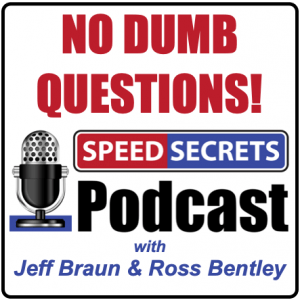Podcast: Play in new window | Download
Subscribe: Apple Podcasts | Amazon Music | RSS
 Welcome back to another episode of No Dumb Questions! Jeff Braun and I sit down to answer your questions, and we promise – there are no dumb questions, maybe just some dumb answers.
Welcome back to another episode of No Dumb Questions! Jeff Braun and I sit down to answer your questions, and we promise – there are no dumb questions, maybe just some dumb answers.
On this episode, Jeff and I discuss what single quantifiable thing relating to a race car are we still unable to reliably measure that would be most useful for finding performance and eye placement when tracking a car. This week’s episode also features a bonus question… tune in to hear what question Ross has for Jeff!
Jeff is one of the very best race car engineers in the world. He’s engineered cars at every level, and every type: NASCAR, karts, club racing cars, Indy, GT and Prototypes, and even Top Fuel dragsters. But what sets Jeff apart from many engineers is how he can explain what he’s doing, what a car is doing, and even how the best think.

Hey Ross, first off I love your podcast and thanks to a ton of your tips (and a Garmin Catalyst) I’ve been dropping tons of time at VIR over the past year, and I always enjoy binge-listening on the way to the track.
I have a broad question and a much more specific one with context for Jeff Braun.
The general/simpler question first: What are some suspension angles/adjustments that few people at the club/amateur level ever talk about/are aware of? We all know about camber/caster/toe/bump steer/corner weights, etc… but what else is there that might be relevant on production based racecars?
And the more specific one comes from a lot of reading and observation. This comes from years of setting up wrong wheel drive strut cars: Why or why not is (all the possible) caster good for a FWD car?
Something that “everyone” says to do is add as much caster as you possibly can. It gives you “dynamic camber”. You turn the wheel and you have a tiny bit more effective camber than before adding caster.
Consequences to that I think are less talked about:
We’ve all noticed “caster jacking” to some degree (pardon the pun) where you turn the wheel and weight shifts from the outside to the inside tire. This is more pronounced with more caster. Many people claim you are “loading the inside tire more”.
If you watch what the wheels do when in the air (taking spring etc out of the equation), due to a combo of steering axis inclination and (almost always) positive scrub radius, the inside wheel gets closer to the ground (extends), and outside wheel moves upwards). This is more pronounced with smaller (closer to negative) offsets.
So if we take an example where we add say 3 degrees of caster:
People claim that this “adds weight to the inside tire”… but since spring rates are not changing at all, does this not mean that the entire body is now just learning over further?
(in my head this is how it works out)
Let’s say it results in a 0.2 deg body lean angle vs the original caster amount, this means you are now 0.2 deg further towards positive on the outside rear suspension when fully loaded in a steady state turn – which in most cases will loosen the car up and “feels” good.
There was a famous FWD VW road racer named Dick Shine who gave unique setup advice. Caster was “evil”. His cars were supposedly FAST but hard to drive at the limit.
Someone on an F1 technical site compiled some engineering info regarding changes in mechanical trail and force sensed through the steering wheel based on caster changes which I’ll copy the excerpt here:
// begin quote //
“If you read the chapter in RCVD on Tire Behavior, you find two images of particular interest here: a plot of Lateral Force (call it Fy) against Slip Angle, and a plot of Aligning Torque (call it Mz) against Slip Angle. You can (and have) to imagine the “sum” of those plots as they are expressed at the steering wheel.
As we add Mechanical Trail, the proportion of the Fy signal sensed at the steering wheel increases. The peak Fy still occurs at the same Slip Angle, and so it’s easy enough to plot a set of cumulative curves for increasing amounts of Mechanical Trail. I did three of them at half, equal and double the amount of force from Mz.
At zero MT, the force at the steering wheel (AT only) peaks before Fy and tends toward zero as Fy is peaking. By an MT of double the AT the force at the steering wheel peaks at about the peak Fy.
All very fine and well…but So What?
My inner nerd is telling me to tell you to think about how we drive a front wheel drive race car thru a corner. What “style” does the stupid car force on its driver if only thru the narrow set of options it allows?
Do we actually drive a front wheel drive race car at peak Fy very much? Do we want, amongst the three driver inputs (eyes, ass, hands) to be reconciled, Peak Fy to be the one we’re sensing thru the wheel?”
// end quote //
Hopefully that wasn’t too much, and I fully expect the answer to be “it depends”. If nothing else I hope it gives you something else to think about and results in an interesting topic for the show!
Thank you guys for your time and the great content!